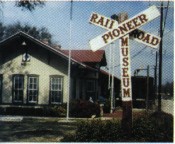


The Gulf, Colorado & Santa Fe Railway Company founded Temple on June 29, 1881. The Santa Fe needed a town at a major junction point to provide services for railroad equipment and passengers. Jonathan Ewing Moore sold 181 acres of farmland for $27 an acre to the railroad, which many thought to be an astronomical price for land with limited water sources. The Santa Fe scheduled a land auction for June 29th. Railroad trains were brought from five cities in Texas with prospective buyers. Those passengers who bought land were refunded their passenger ticket price. There was a party, barbecue and auction of town lots. After June 29th, land continued to be sold to new residents for $45 to $300 a lot from Moore and other sources. Temple was named for Mr. Bernard Moore Temple, the Gulf, Colorado & Santa Fe Railway chief engineer, who built the tracks through Bell County.
Temple had many nicknames in its earlier days. It was named Mudville for its thick blackland prairie soil; Tanglefoot for both its mud and for its reputation as a wild frontier town; and Ratsville for its abundant supply of those four-legged creatures. However, the face of Temple was soon to change. Arriving trains brought women, children, china, crystal, and all the touches of modern society. Whole families loaded their furniture, tools, animals and sometimes even themselves onto boxcars and came to Temple to settle. Temple grew very fast, and became "Progressive Temple" and the "Prairie Queen." It also became known as the "City of Trees" due to Mr. Goodrich Jones, a resident who is the father of Arbor Day in Texas and the Texas Forestry Association.

Railroads connected the city to the rest of the state. By 1897 there were four railway lines in Temple: the main line and San Angelo branch of the Santa Fe, the main line and Belton branch of the Missouri, Kansas, and Texas. Each day there were 23 trains carrying passengers to and from the city. In the spring of 1894, the Temple Cold Storage and Ice Factory was furnishing ice to the Santa Fe. By 1900, a city sewer system was installed, and in 1905, there was an artificial gas plant. In that same year, the Interurban (trolley car system) between Temple and Belton was built.
Water was always a problem in Temple, as it had no inexpensive natural water source. Wells were dug, and some sold water for fifty cents a barrel. Temple tried several different projects including building a huge water stand pipe (which promptly collapsed upon filling). The second standing water pipe replaced it and helped the availability of water. The Santa Fe Railway dammed Bird Creek and created Lake Polk for refilling steam engines passing through Temple. Finally water was piped from the Leon River, and now comes from Lake Belton.
By 1908, there were two oil mills, two planing mills, twenty-two physicians, six dentists, eight druggists, twelve real estate men, six restaurants (Chinaman Ling's being the favorite), three hotels, twelve lawyers, six cotton gins, four wholesale groceries, twelve churches, several lumber yards, three cotton compresses, one race track and one fair ground just north of Lake Polk. Temple was on its way to becoming an important city for commerce, railroads and medicine.

The railroad remained a major employer for Temple, and in 1891 established the Gulf, Colorado & Santa Fe Railway Hospital in the city. Railroad employees who were injured or became ill on the line and needed treatment were sent to the Temple "Santa Fe Hospital." Dr. Arthur Carroll Scott and Dr. Raleigh R. White, Jr., who moved to Temple to work in the Santa Fe Hospital, saw the need to broaden their practices to include Temple residents, and opened the Temple Sanitarium in 1904 (which became the Scott & White Memorial Hospital and Clinic). In addition, in 1896, King's Daughters Hospital was established to care for the community and those less fortunate.
In 1909, the agri-business suffered a major setback. An airborne fungus destroyed the cotton crops. This led to the establishment of the Blackland Research Center in 1912. Still located in Temple today, this center has been the site of continued agricultural research in the state.
The onset of World War II was the impetus for much growth in Central Texas and in Temple. In 1941, Camp Hood was established as a training camp for the "Tank Destroyers." And in 1942, construction began on McCloskey General Hospital, a 2500-bed medical facility to care for and rehabilitate the wounded soldiers and amputees. During World War II, a prisoner of war camp was situated just west of the hospital, where Temple College is now located.

Today, Temple continues to look to a bright future. From the small beginnings and great hopes of early Temple residents, the city has become a strong community based on manufacturing, medical care, agriculture, and rail transportation.